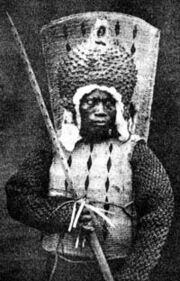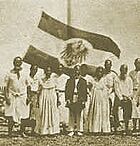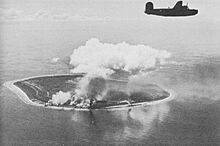History of Nauru facts for kids
Quick facts for kids History of Nauru |
|
|---|---|

The flag of Nauru reflects the 12 original tribes that inhabited the country
|
|
| Historical Periods | |
| Pre-history | until 1888 |
| German Rule | 1888–1919 |
| Australia trust | 1920–1967 |
| Japanese Rule | 1942–45 |
| Republic | 1968–present |
| Major Events | |
| Phosphate originally found | 1900 |
| Collapse of phosphate industry | 2002 |
The history of human activity in Nauru, an island country in the Pacific Ocean, began roughly 3,000 years ago. At that time, different groups of people settled on the island.
Contents
Early Life on Nauru
Around 3,000 years ago, people from Micronesia settled Nauru. There are also signs that people from Polynesia might have visited or lived there. The early Nauruans ate coconut and pandanus fruit. They also practiced a special kind of fishing. They would catch young ibija fish, get them used to fresh water, and then raise them in Buada Lagoon. This gave them a steady supply of food. Only men were allowed to fish on the reef, using canoes or trained man-of-war hawks.
Nauru traditionally had 12 clans or tribes. These 12 tribes are shown by the 12-pointed star on the nation's flag. Nauruans traced their family lines through their mothers, which is called matrilineal descent.
First European Encounters
The first Europeans to see Nauru were on a British whaling ship called Hunter in 1798. When the ship came close, many canoes came out to meet it. The ship's crew did not leave, and the Nauruans did not board. However, Captain John Fearn liked what he saw of the island and its people. He named it "Pleasant Island." This name was used for 90 years until Germany took control.
Around 1830, Nauruans started meeting Europeans from whaling ships and traders. These ships would stop at Nauru to get supplies like fresh water. The first Europeans to live on the island were two Irishmen who had escaped from a prison island. One of them, John Jones, caused trouble for other Europeans who arrived later. The Nauruans eventually made him leave the island in 1841.
Changes and Conflict
The arrival of new goods like firearms and alcohol changed how the 12 tribes got along. A 10-year internal war started in 1878. This war caused the population to drop from 1,400 people in 1843 to about 900 by 1888. Eventually, alcohol was banned, and some weapons were taken away.
German Rule
In 1886, Germany was given control of Nauru under an agreement with Britain. Germany officially took over the island in 1888. It became part of Germany's New Guinea Protectorate. German troops arrived on Nauru on April 16, 1888. This arrival helped end the Nauruan Civil War.
On October 1, 1888, a German gunboat called SMS Eber landed 36 soldiers on Nauru. The German marines marched around the island. They returned with the 12 chiefs, the white settlers, and a missionary. The chiefs were held until the next morning. On October 2, the German flag was raised, marking the official takeover. The Germans told the chiefs they had to give up all their weapons and ammunition within 24 hours. If they did not, the chiefs would be taken prisoner. By October 3, 765 guns and 1,000 rounds of ammunition had been handed over.
The Germans called the island Nawodo or Onawero. Their arrival ended the war. Social changes from the war led to kings ruling the island. King Auweyida was one of the most well-known. Christian missionaries also arrived in 1888. Germany ruled Nauru for almost 30 years. Robert Rasch, a German trader who married a local woman, was the first administrator in 1888.
Nauru's Tribes and Phosphate Discovery
At that time, Nauru had 12 tribes: Deiboe, Eamwidamit, Eamwidara, Eamwit, Eamgum, Eano, Emeo, Eoraru, Irutsi, Iruwa, Iwi and Ranibok. Today, these 12 tribes are shown by the 12-pointed star on the flag of Nauru.
A valuable mineral called phosphate was found on Nauru in 1900 by Albert Fuller Ellis. The Pacific Phosphate Company began mining these reserves in 1906, with Germany's permission. The company sent its first shipment of phosphate in 1907.
From World War I to World War II
In 1914, when World War I began, Australian troops captured Nauru. Britain then controlled the island until 1920. In 1919, Australia, New Zealand, and the United Kingdom signed an agreement. They created a group called the British Phosphate Commission (BPC). This group took over the rights to mine phosphate on Nauru.
In 1923, the League of Nations gave Australia the job of looking after Nauru. The United Kingdom and New Zealand were co-trustees. In 1932, the first Angam Baby was born. This was a special event because it meant the Nauruan population had recovered after a period of decline.
World War II on Nauru
During World War II, Nauru suffered a lot of damage. Both German and Japanese forces, and later Allied forces, caused destruction.
In December 1940, two German ships sank four merchant ships near Nauru. The next day, one of the German ships shelled Nauru's phosphate mining areas and oil storage. These attacks greatly reduced the phosphate supplies going to Australia and New Zealand. Phosphate was important for making ammunition and fertilizer.
Japanese troops took over Nauru on August 26, 1942. They treated the local Nauruans very harshly. The Japanese built two airfields on Nauru. These airfields were bombed for the first time on March 25, 1943. This stopped food supplies from reaching Nauru by air. In 1943, the Japanese sent 1,200 Nauruans to work as laborers in the Chuuk islands.
Nauru was finally freed from the Japanese on September 13, 1945. Captain Soeda, the Japanese commander on Nauru, surrendered the island to the Royal Australian Navy and Army. This surrender happened on the warship HMAS Diamantina. Plans were made to bring back the 745 Nauruans who had survived being held by the Japanese in Chuuk. They returned to Nauru on January 1, 1946, on the BPC ship Trienza.
Trust Territory Period
In 1947, the United Nations set up a trusteeship for Nauru. Australia, New Zealand, and the United Kingdom became the UN trustees. Australia mostly handled the day-to-day running of the island. By 1965, the population reached 5,561 people. Just under half of these were Nauruan.
In July 1966, the Nauruan Head Chief spoke at the United Nations Trusteeship Council. He asked for Nauru to become independent by January 31, 1968. The UN General Assembly supported this in December of that year. Australia and the other ruling powers tried to suggest other options besides full independence. They thought Nauru could have self-government, but with Australia still involved in foreign affairs. They were worried about such a small community becoming a fully independent country.
However, Nauru rejected these ideas. Australia was also concerned that the UN might not accept these plans. In June 1967, it was agreed that the British Phosphate Commission's assets on the island would be sold to Nauru for 21 million Australian dollars. Nauru was granted full independence on January 31, 1968.
Independence and Phosphate Wealth
Nauru became self-governing in January 1966. On January 31, 1968, after two years of planning its new government, Nauru became the world's smallest independent republic. It was led by its first president, Hammer DeRoburt. In 1967, the people of Nauru bought the assets of the British Phosphate Commissioners. In June 1970, control of phosphate mining went to the Nauru Phosphate Corporation, which was owned by Nauru.
The money earned from phosphate mining was put into the Nauru Phosphate Royalties Trust. This made Nauruans very wealthy. They had one of the highest incomes per person in the world at that time.
In 1989, Nauru took legal action against Australia in the International Court of Justice. Nauru complained that Australia had not fixed the environmental damage caused by phosphate mining. This case led to an agreement outside of court. Australia agreed to pay Nauru to help fix the mined-out areas.
By the end of the 1900s, the phosphate supplies were quickly running out. Nauru finally joined the UN in 1999.
Modern-Day Nauru
As Nauru's phosphate stores ran out (they were gone by 2006), much of the island became an environmental wasteland. Nauru asked the International Court of Justice for money to make up for the damage. This damage was from almost a century of phosphate mining by foreign companies. In 1993, Australia offered Nauru an agreement to pay A$2.5 million each year for 20 years. New Zealand and the UK also agreed to pay a one-time amount of $12 million each.
Falling phosphate prices, the high cost of running an international airline, and the government's money problems caused Nauru's economy to struggle in the late 1990s. By the year 2000, Nauru was almost bankrupt.
Recent Leaders
President Bernard Dowiyogo took office in April 2000. He had served as president several times before. He was president from 1976 to 1978, and again from 1989 to 1995. He became president again in 1998.
After the parliamentary elections in 2013, Baron Waqa was elected president. He was president for six years, from 2013 to 2019. President Waqa supported Australia keeping refugees in a camp on Nauru. In the 2019 Nauruan parliamentary election, President Waqa lost his seat in parliament, meaning he could not be re-elected. In August 2019, parliament chose Lionel Aingimea, a former human rights lawyer, as the new President of Nauru. After the 2022 Nauruan parliamentary election, Russ Kun was elected president. On October 30, 2023, David Ranibok Adeang was elected President of Nauru.
See also
 In Spanish: Historia de Nauru para niños
In Spanish: Historia de Nauru para niños
- Nauruan Civil War
- Angam Day
- Japanese occupation of Nauru
- History of Oceania
- President of Nauru
- List of colonial governors of Nauru
- Nauru Phosphate Corporation
- Nauru Phosphate Royalties Trust
- Politics of Nauru





